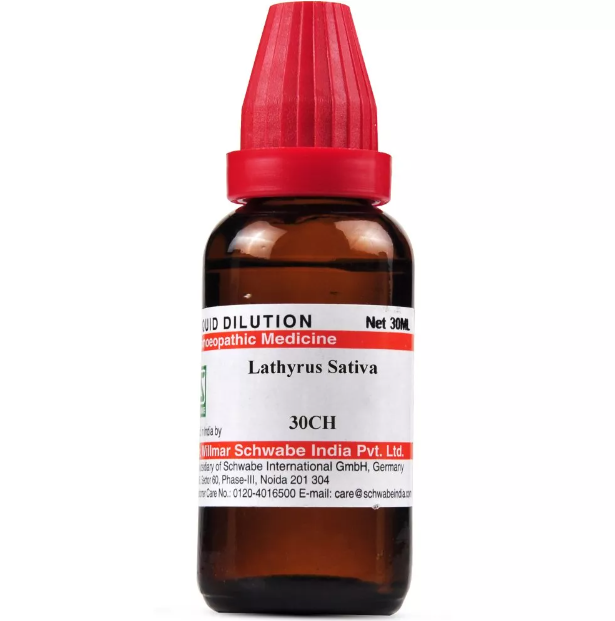LATHYRUS SATIVUS Q, 6C, 12C, 30C, 200C, 1M, 10M USES AND SYMPTOMS
 LATHYRUS SATIVUS
LATHYRUS SATIVUS
(Chick-pea)
Lath.
Affects the lateral and anterior columns of the spinal cord without causing pain. Reflexes are always increased. Causes paralysis in the lower extremities, spastic paralysis, lateral sclerosis, Beri-beri, athetosis, locomotor ataxia, and infantile paralysis. Often follows influenza and exhaustive diseases, resulting in weakness and slow nerve recovery. Symptoms include sleepiness and constant yawning.
Mind: Depressed, hypochondriacal, experiences vertigo when standing with eyes closed.
Mouth: Burning pain on the tip of the tongue, with tingling and numbness of the tongue and lips, as if scalded.
Urinary: Increased bladder reflex, frequent urination, must hurry or risk involuntary voiding.
Extremities: Numb fingertips, tremulous and tottering gait, excessive leg rigidity, spastic gait, knees knock together when walking. Cramps in legs worsen in the cold, feet are cold. Difficulty extending or crossing legs when sitting. Myelitis with marked spastic symptoms, rheumatic paralysis, emaciation of gluteal muscles and lower limbs (paraplegia). Legs turn blue and swell if hanging down. Stiffness and lameness in ankles and knees, toes do not leave the floor, heels do not touch the floor. Calf muscles are very tense. The patient sits bent forward and straightens up with difficulty.
Relationship: Compare with Oxyt., Sec., Petiveria tetandra (paralysis; paraplegia with numbness, sensation of internal coldness), and Agrostemma githago Corncockle (burning sensation in the stomach, esophagus, throat, lower abdomen, and anus; nausea, bitter vomiting, impaired locomotion; difficulty remaining erect, vertigo, headache, burning from the lower jaw to the vertex).
Dose: Third potency.
SYMPTOMS OF LATHYRUS SATIVUS
Mind:
Depression
Hypochondria
Vertigo when standing with eyes closed
Mouth:
Burning pain on the tip of the tongue
Tingling and numbness of tongue and lips, as if scalded
Urinary:
Increased bladder reflex
Frequent urination
Urgency to urinate, risk of involuntary voiding
Extremities:
Numb fingertips
Tremulous, tottering gait
Excessive rigidity of legs
Spastic gait
Knees knock together when walking
Leg cramps worsened by cold, cold feet
Difficulty extending or crossing legs when sitting
Myelitis with spastic symptoms
Rheumatic paralysis
Emaciated gluteal muscles and lower limbs (paraplegia)
Legs turn blue and swell if hanging down
Stiffness and lameness in ankles and knees
Toes do not leave the floor, heels do not touch the floor
Tense calf muscles
Difficulty straightening up from a bent forward sitting position
selection of the potency
Individualization:
- Homeopathy is based on the principle of treating the individual, not just the disease. The unique symptoms and characteristics of the person are crucial in determining the most suitable potency.
Intensity of Symptoms:
- The intensity of the symptoms guides the choice of potency. If the symptoms are intense and acute, a lower potency (e.g., 6C, 30C) might be considered. For chronic conditions with less intensity, higher potencies (e.g., 200C, 1M) may be appropriate.
Sensitivity of the Patient:
- Some individuals are more sensitive to homeopathic remedies, while others may require higher potencies. The practitioner considers the patient’s sensitivity when selecting the potency.
Acute vs. Chronic Conditions:
- Lower potencies are often used for acute conditions, while higher potencies may be considered for chronic or long-standing issues.
Previous Response to Potencies:
- The patient’s response to previous homeopathic treatments helps guide the choice of potency. If a particular potency has been effective in the past, it may be repeated or adjusted as needed.
Vital Force and Susceptibility:
- Homeopathy views illness as a disturbance in the vital force. The practitioner assesses the patient’s overall vitality and susceptibility to determine the appropriate potency.
Aggravation or Amelioration:
- The direction of the symptom response (aggravation or amelioration) after taking a remedy can influence the choice of potency.
Miasmatic Considerations:
- In classical homeopathy, the concept of miasms (inherited disease tendencies) is considered. The practitioner take this into account when selecting the potency.
Practitioner Experience:
- The experience and preference of the homeopathic practitioner play a role. Some practitioners may have success with certain potencies based on their clinical experience.
SAFETY INFORMATION
- Do not exceed the recommended dose by physician
- Keep out of the reach of children
- Store in a cool dry place away from direct sunlight
- Maintain half an hour gap between food/drink/any other medicines and homoeopathic medicine
- Avoid any strong smell in the mouth while taking medicine e.g. camphor, garlic, onion, coffee, hing
Medicine images use for reference only selection of homeopathic medicine depends on the individual’s specific symptoms and overall constitution. Moreover, homeopathy is a holistic system of medicine that treats the individual as a whole. In addition to addressing the physical symptoms, it takes into account the emotional and mental state of the person. Consequently, it’s crucial to consult with a qualified homeopathic practitioner for personalized treatment.
The information provided on this website is intended solely for educational purposes. Always seek the advice of your physician or other qualified health provider.
